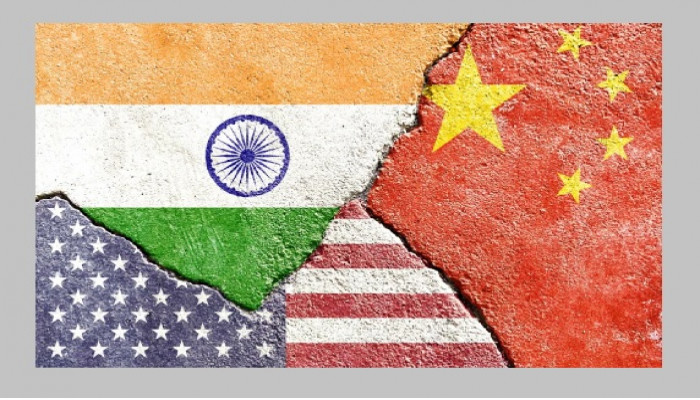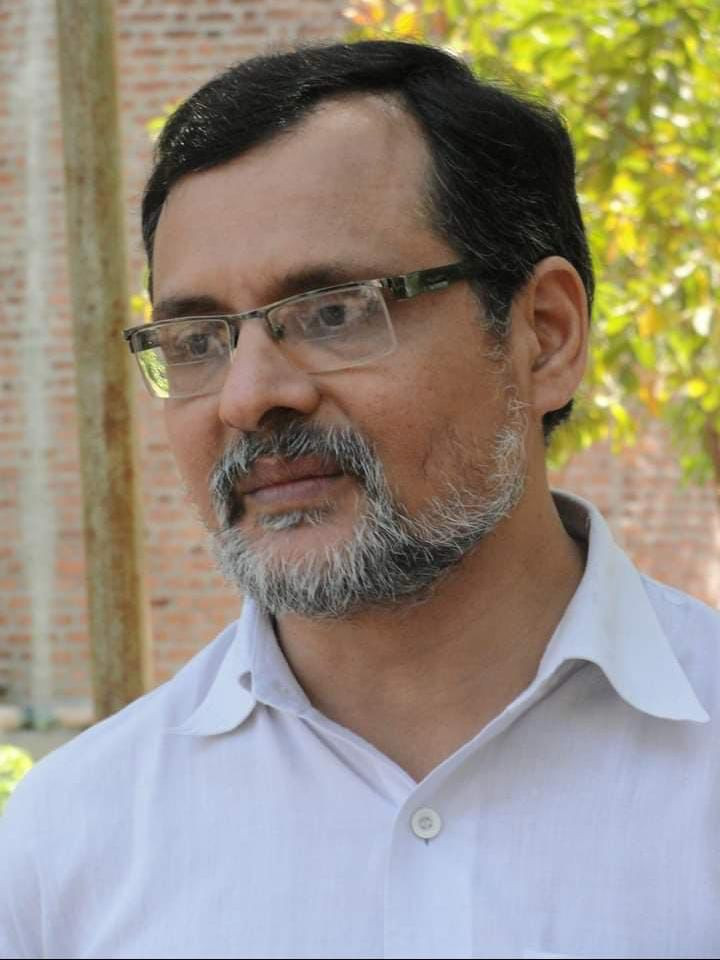Should India remain equidistant from the U.S. and CCP-occupied China: A 12-point Analysis
- In Military & Strategic Affairs
- 11:16 PM, Sep 28, 2025
- Viren S Doshi
India, as a rising global power, faces seemingly complex choices in navigating its relationships with two of the world’s most influential powers: the United States and the Chinese Communist Party (CCP)-occupied China. The transactional diplomacy of the Trump-Vance administration has sparked debates in India about whether to maintain a neutral stance between the two major powers.
While reactionary appeals for distancing from the U.S. may resonate amid current uncertainties born out of generically transactional (foreign as well as domestic, not particularly India-specific) policies and actions of the Trump Administration, a rational examination reveals stark contrasts between the two powers in terms of historical ties, geopolitical dynamics, and their impact on India’s interests. Over and above, it also reveals the inevitability of mutual synergistic interdependence of India and the U.S. for countering the threats of an expansionist CCP-occupied China-led nexus comprising Communists, Leftists, Socialists, Naxalites, Jihadis, Colonialists, Globalists, Wokeists, Racists and Supremacists; inimical to both India and the U.S.
This article provides a 12-point comprehensive comparison of the U.S. and CCP-occupied China, incorporating historical context, current geopolitical realities, and key issues such as border disputes, terrorism, riparian rights, cultural impacts, economic transparency, diaspora strengths, global influence, cross country relations, and most importantly the shared vulnerabilities to opaque and inaccessible CCP-occupied China’s manipulations in Indian and American democratic spaces.
1. Historical Context: A Tale of Trust, Tensions, and Transcendental Ties
United States:
India’s relationship with the United States has evolved significantly since India’s independence in 1947, with deep historical roots in shared anti-colonial sentiments and cultural exchanges. The “new-world” nation U.S.’s founding fathers — George Washington, John Adams, Benjamin Franklin, and Thomas Jefferson — were conservative anti-colonial leaders whose revolutionary ideals against British imperialism resonated with India’s own struggle for freedom. Abraham Lincoln, another towering figure, championed liberty, inspiring anti-colonial movements worldwide.
This spiritual alignment laid the groundwork for mutual respect, even as Cold War dynamics created tensions. India’s non-aligned and yet pro-Russia (USSR) stance and the U.S.’s alignment with Pakistan, particularly through military aid since the 1950s and 1960s, increased the friction, as India perceived Pakistan’s hostility as a threat.
Cultural bridges were built by luminaries like Swami Vivekananda, whose 1893 speech at the World Parliament of Religions in Chicago introduced Indian philosophy to the West, influencing American thinkers like Ralph Waldo Emerson, Walt Whitman, and Henry David Thoreau, who embraced transcendentalism inspired by Indian texts like the Bhagavad Gita. The bridges held the ground all through the vicissitudes. Martin Luther King Jr., inspired by Mahatma Gandhi, further deepened this East-West connection through his adoption of nonviolent resistance.
Since the 1990s, post-Cold War, U.S.-India relations have warmed, driven by shared democratic values and mutual concerns about the CCP-occupied China’s rise based on anti-democratic and unfair practices. Republican President Ronald Reagan’s emphasis on freedom and democracy aligned with India’s ethos, setting the stage for closer ties.
The landmark 2008 U.S.-India Civil Nuclear Agreement, championed by Republican President George W. Bush, marked a turning point, symbolising trust and cooperation in energy and security. Under President Donald Trump, the strengthening of the Quadrilateral Security Dialogue (Quad) in the late 2010s further solidified India’s strategic partnership with the U.S., Japan, and Australia. Today, the U.S. hosts over 4 million Indian Americans, who contribute significantly to its economy and society, fostering deep cultural and economic ties.
CCP-Occupied China:
The historical relationship between India and the CCP-occupied China is marked by betrayal and conflict by the latter, despite earlier cultural harmony. Ancient exchanges via the Silk Road and the spread of Buddhism from India to China fostered goodwill. However, the CCP’s usurpation of power in 1949 and its annexation of Tibet in 1950 diametrically altered this age-old dynamic. The 1962 Sino-Indian War, where the CCP-occupied China attacked India out of its expansionist appetite, remains a defining trauma. The occupation of Sakshgam Valley, and Aksai Chin and unfounded claims over Arunachal Pradesh continue to fuel distrust. CCP-occupied China’s support for Jihadi and rogue state Pakistan during the 1971 Indo-Pakistan War and its condemnation of India as a “tool of Soviet expansionism” further strained ties. Despite periods of détente, such as the official visits of the leaders, the relationship remains overshadowed by CCP-occupied China's expansionist and anti-India tactics and tantrums.
Comparison:
The U.S. shares values with India, rooted in anti-colonialism, democratic ideals, and intellectual exchanges espoused by Vivekananda, Emerson, and King, alongside political leaders like Reagan, Bush, Modi and to an extent Trump. While Cold War tensions with the U.S. existed, it never engaged in direct aggression against India.
Even the F-16 fleet given to Pakistan is conditional; these fighter jets are not to be used against India. In contrast, CCP-occupied China’s history includes military conflict and territorial violations, making it a more immediate security threat. The U.S.’s open society and English-speaking Indian diaspora’s integration with their adopted nation contrast sharply with CCP-occupied China’s opaque system and limited Indian presence due to its closed, inaccessible and sinister systems. As long as the CCP is there, it would be difficult for India to relate with China, given CCP’s clandestine agenda.
2. Territorial Integrity - Border Disputes
United States:
The United States has no territorial disputes with India, and its strategic partnership has bolstered India’s position against regional threats. The U.S. supports India’s role in the Indo-Pacific, particularly through the Quad, which includes India, the U.S., Japan, and Australia. This partnership aims to ensure a free and open Indo-Pacific, countering CCP-occupied China’s aggressive expansionism or neo-colonialism. The U.S. has also supported India’s stance on terrorism, including condemning attacks in Kashmir and advocating for the designation of Pakistan-based terrorists at the United Nations, though it has a legacy of alliance with Pakistan.
CCP-Occupied China:
CCP-occupied China poses a direct threat to India’s territorial integrity. It occupies 38,000 square kilometres of Aksai Chin in Ladakh, an integral part of India, and asserts baseless claims over 90,000 square kilometres of Arunachal Pradesh, calling it “South Tibet.” The Line of Actual Control (LAC) remains contested, with frequent incursions, such as the 2020 Galwan Valley clash that resulted in martyrdom of 20 Indian soldiers, while many more Chinese Communist aggressors were eliminated.
Over the last couple of decades, India has been the only country that has directly fought and repelled the CCP forces. CCP-occupied China’s infrastructure buildup in Tibet and its rejection of the 1914 Simla Convention exacerbate tensions. Its military cooperation with Pakistan all along decades, and specifically even during Operation Sindoor, including the China-Pakistan Economic Corridor (CPEC), which passes through Pakistan-occupied Kashmir, further complicates India’s security landscape.
Comparison:
The U.S. poses no territorial threat and largely supports India’s strategic interests despite its legacy alliances with Pakistan and Turkey, while CCP-occupied China’s illegal occupation of Indian territory and ongoing baseless claims, along with its machinations in Pakistan and other countries around, represent a persistent challenge. The U.S.’s diplomatic support contrasts with CCP-occupied China’s aggressive posturing, making the latter a more immediate concern for India’s sovereignty.
3. Support for Jihadi Terrorism and Regional Manipulations
United States:
The U.S. has a complex history with Pakistan, a key player in regional terrorism. While the U.S. has provided military aid to Pakistan, its post-9/11 focus on counterterrorism has led to pressure on Pakistan to curb militant groups like Lashkar-e-Taiba (LeT) and Jaish-e-Mohammad (JeM), which target India. The U.S. designated LeT as a Foreign Terrorist Organisation and has supported India’s calls for action against Pakistan-based terrorists. However, India remains frustrated by the U.S.’s Major Non-NATO Ally (MNNA) status for Pakistan, which some perceive as contradictory given Pakistan’s alleged support for terrorism. The U.S.’s stance during and in the aftermath of the 2025 India-Pakistan crisis, following the Pahalgam attack, further fuelled Indian scepticism.
CCP-Occupied China:
CCP-occupied China’s support for Pakistan significantly aggravates India’s security challenges. Since the 1960s, China has cultivated Pakistan as a strategic ally to counterbalance India. This includes providing military hardware, nuclear technology, and diplomatic cover. CCP-occupied China has repeatedly blocked UN efforts to designate Pakistan-based terrorists like Masood Azhar as global terrorists. Its intelligence-sharing and supply of J-10 fighter jets to Pakistan, used in the 2025 India-Pakistan crisis, highlight its role in enabling Pakistan’s military capabilities. In West Asia, CCP-occupied China’s growing ties with Ayatollah's Regime in Iran and its Belt and Road Initiative (BRI) investments in Pakistan and other countries amplify its regional influence, often at India’s expense.
Comparison:
While the U.S.’s relationship with Pakistan creates tensions, its counterterrorism cooperation with India aligns with Indian interests. In contrast, CCP-occupied China’s overt support for Pakistan, including its role in enabling terrorism, makes it a more significant threat to India’s security. CCP-occupied China’s manipulations in West Asia further complicate India’s regional strategy.
4. Tibet - Cultural Destruction of Buffer State
United States:
The U.S. has consistently criticised the CCP-occupied China’s human rights abuses in Tibet, including the destruction of Tibetan culture and religious freedoms. The U.S. Tibet Policy and Support Act of 2020 reinforces its stance against the CCP-occupied China’s actions.
CCP-Occupied China:
The CCP’s illegal and forced annexation of Tibet in 1950 and subsequent cultural annihilation, including the destruction of monasteries and restrictions on Tibetan Buddhism, have impacted India as the Tibetan buffer state was annexed with brutal force. Tibet, traditionally a buffer state, now serves as a militarised zone for CCP-occupied China, threatening India’s northern borders. The Dalai Lama’s presence and India's provisions for shelter to Tibetan refugees in India since 1959 are almost a standalone mission in which no one, including the UN, ever supported.
Comparison:
The U.S. supports India’s position on Tibet, while CCP-occupied China’s genocidal actions in Tibet directly threaten India’s security and resources. The cultural destruction in Tibet further highlights CCP-occupied China’s disregard for shared historical ties with India.
5. Riparian Issues - Water Theft
United States:
The U.S. has no direct involvement in India’s riparian disputes but supports India’s environmental and strategic interests through initiatives like the Partnership for Global Infrastructure and Investment, which counters CCP-occupied China’s BRI.
CCP-Occupied China:
CCP-occupied China’s upstream control of rivers like the Brahmaputra violates riparian water-sharing norms, with dam construction and potential water diversion posing risks to India’s northeastern states. It has avoided doing any treaty with any of the lower riparian countries, including India, to avoid water sharing arrangements.
Comparison:
The U.S. aligns with India's environmental concerns, while CCP-occupied China’s riparian violations directly threaten India’s security and resources.
6. Indo-Pacific Sea Lanes and Global Maritime and Strategic Influence
United States:
The U.S. promotes a free and open Indo-Pacific (this phrase is promoted by the U.S. as against “Asia-Pacific” since and under the first term of Trump), aligning with India’s vision of a multipolar regional order. Through the Quad, the U.S. supports India’s role as a regional security provider, ensuring open sea lanes critical for global trade. The U.S.’s open economy and transparent governance contrast with CCP-occupied China’s opaque system, fostering trust in bilateral trade and investment. The U.S.’s global influence, rooted in democratic values, resonates with India’s aspirations.
CCP-Occupied China:
CCP-occupied China’s blatantly aggressive actions in the South China Sea and its BRI projects, such as the Gwadar port in Pakistan and Hambantota in Sri Lanka, threaten Indo-Pacific sea lanes. Its “string of pearls” strategy aims to encircle India, raising concerns about maritime security. CCP-occupied China’s global influence, driven by economic coercion and authoritarian governance, contrasts with India’s democratic ethos. Its opaque economy and lack of transparency in financial dealings, including black money in tax havens, further erode trust.
Comparison:
The U.S.’s Indo-Pacific strategy aligns with India’s interests, promoting open sea lanes and democratic values, while CCP-occupied China’s actions threaten regional stability and India’s maritime security. The U.S.’s transparent system contrasts with CCP-occupied China’s opaque financial practices.
7. Indian Diaspora and Work Visas
United States:
The U.S. hosts over 4 million Indian Americans, who are among the most successful immigrant communities, contributing to technology, healthcare, and academia. Despite leftist and racist propaganda against this most loyal and law-abiding community, Indian Americans hold prominent positions, from corporate CEOs to political leaders, strengthening U.S.-India ties. Despite immigration policy reforms by the Trump Administration, the U.S. still remains a preferred destination for Indian talent.
CCP-Occupied China:
Fewer than 10,000 Indians reside in CCP-occupied China, primarily as students or temporary workers. The lack of a significant Indian diaspora reflects limited economic and cultural integration, inherent hostilities and severe trust deficit apart from language and freedom-related barriers. CCP-occupied China’s restrictive visa policies and controlled environment deter Indian professionals, contrasting sharply with the opportunities available in the U.S. as a free world democratic nation.
Comparison:
The U.S.’s large, integrated Indian diaspora fosters strong bilateral ties, while the negligible Indian presence in CCP-occupied China limits cultural and economic connections. The U.S.’s still relatively open immigration policies contrast with CCP-occupied China’s restrictive approach.
8. Democracy, Liberty, and Economic Transparency
United States:
As the world’s largest democracy, the U.S. shares India’s commitment to democratic values and individual rights and liberties. Its transparent economy, despite imperfections, provides a predictable environment for trade and investment. The U.S.’s open society allows for scrutiny of its policies, aligning with India’s democratic ethos. However, India faces U.S. foreign policy upheavals, particularly under leftist rule and also at times under conservative rule. The inconsistencies of the left and transactional approach of the right impact India adversely, but the rule of the right wing is still better than the left if one takes into account the vulnerability of the U.S. itself and the implications of the leftist policies at the global level.
CCP-Occupied China:
CCP-occupied China’s authoritarian system lacks democracy and suppresses liberties, as seen in its treatment of Uyghurs, Tibetans, and dissidents. Its economy is opaque, with state-controlled enterprises and limited transparency in financial dealings. Reports of black money in tax havens, such as the Panama Papers, highlight CCP elites’ involvement in illicit financial flows, undermining trust. This opacity contrasts with India’s fairly open economic system and democratic governance.
Comparison:
The U.S.’s democratic system and economic transparency align with India’s values, fostering trust, while CCP-occupied China’s authoritarianism and opaque economy create suspicion. The U.S.’s open society supports India’s global aspirations, unlike CCP-occupied China’s restrictive hegemony.
9. Deep State and Political Manipulation
United States:
Concerns about a U.S. “deep state”, mainly rooted in leftist, liberal, Communist, Globalist, Jihadi and racist forces influencing Indian politics, do exist. The U.S.’s open political system and free press allow for scrutiny of such claims, reducing their impact. While U.S. foreign policy can be transactional, as seen in the Trump-Vance administration’s approach, it operates within a democratic framework, allowing India to engage as an important stakeholder not necessarily with any enmity.
CCP-Occupied China:
CCP-occupied China’s deep state, driven by the CCP’s intelligence and propaganda apparatus, actively manipulates regional politics. Its support for anti-India narratives in Pakistan and influence in neighbouring countries like Nepal and Bangladesh undermines India’s regional standing. The CCP’s global influence operations - including in agencies like the UN and including disinformation campaigns - pose a significant threat to India’s democratic processes.
Comparison:
The U.S.’s transparent system mitigates concerns about American leftist or racist deep state-driven political manipulation, while CCP-occupied China’s covert operations pose a direct threat to India’s sovereignty and regional influence. The U.S.’s democratic accountability contrasts with CCP-occupied China’s opaque interventions.
10. Manipulation in Democratic Spaces and Freedom of Expression
United States:
As democracies, both the U.S. and India face vulnerabilities to CCP-occupied China’s manipulations in their open political and media ecosystems. CCP-occupied China has been documented exploiting the U.S.’s free media, social media platforms, and freedom of speech to spread disinformation, influence public opinion, and fund leftist and wokeist political outfits that align with its narratives and that destroy faith and family systems. For example, reports indicate that CCP-linked entities have used funding to influence academic institutions, think tanks, and media outlets in the U.S., promoting anti-America and anti-India as well as anti-Semitic or pro-CCP and Wokeist narratives. The open internet in the U.S. allows CCP-affiliated actors to operate covertly, leveraging platforms like X to amplify divisive content. Despite these challenges, the U.S.’s democratic framework enables counter-responses through transparency, free press scrutiny, and legal measures, such as the Foreign Agents Registration Act (FARA), to curb foreign influence.
CCP-Occupied China:
In contrast, CCP-occupied China offers no space for democratic participation, free speech, or fundamental rights. Its tightly controlled internet, known as the Great Firewall, censors dissent and restricts access to global platforms. Political opposition is nonexistent, and religious and cultural freedoms, such as those of Tibetans and Uyghurs, are suppressed. CCP-occupied China’s authoritarian system prevents any reciprocal influence from India or the U.S., as it lacks independent media, open social media, or political pluralism. This asymmetry allows CCP-occupied China to exploit the open systems of democracies like India and the U.S. while shielding itself from similar interference. For India, CCP-occupied China’s influence operations target its democratic spaces, funding anti-India narratives through proxies, manipulating social media, and infiltrating civil society, posing a direct threat to its democratic integrity.
Comparison:
The U.S. and India, as democracies, share a common vulnerability to CCP-occupied China’s manipulations through their open media, internet, and political systems. However, this shared challenge underscores their alignment against CCP-occupied China’s authoritarian tactics. The U.S.’s transparent mechanisms to counter foreign influence align with India’s efforts to safeguard its democracy, such as banning Chinese apps like TikTok in 2020 over security concerns. CCP-occupied China’s closed system, devoid of freedoms, prevents any mutual engagement and amplifies its ability to destabilise democratic societies. India cannot hyphenate the U.S. with CCP-occupied China; both nations are in the same boat, facing similar threats from CCP-occupied China’s manipulation of their democratic spaces, necessitating closer cooperation to counter these influence operations.
11. U.S.-Turkey Relations, Turkey’s Role in NATO, and U.S. Nuclear Weapons Deployment
United States:
Turkey, a key member of the North Atlantic Treaty Organisation (NATO) since 1952, hosts approximately 50 U.S. B61 nuclear gravity bombs at Incirlik Air Base, part of NATO’s nuclear-sharing program aimed at deterring Soviet (now Russian) aggression. These weapons, under U.S. control but deployable by Turkish F-16s in wartime with U.S. authorization, symbolise America’s commitment to Turkey’s defence. U.S.-Turkey relations, however, have faced strains, particularly since the 2016 Turkish coup attempt, Turkey’s purchase of Russian S-400 missile systems in 2017, and its 2019 incursion into Syria against U.S.-allied Kurdish forces. The U.S. imposed sanctions on Erdogan's Turkey in 2020 under the Countering America’s Adversaries Through Sanctions Act (CAATSA) for the S-400 deal, citing threats to NATO’s security and the F-35 program, from which Turkey was expelled.
Despite these tensions, Turkey’s strategic location—controlling access to the Black Sea via the Bosporus and hosting NATO facilities like the Kürecik radar station—makes it indispensable to the alliance. From India’s perspective, Turkey’s NATO role and U.S. nuclear presence enhance NATO deterrence against Russia. However, Turkey’s growing ties with Russia and Iran, both aligned with CCP-occupied China, raise concerns about its reliability as a NATO partner, potentially complicating India’s strategic calculus in West Asia.
CCP-Occupied China:
CCP-occupied China has strengthened ties with Turkey through the Belt and Road Initiative, including investments in Turkish infrastructure like the Yavuz Sultan Selim Bridge and the Ankara-Istanbul high-speed railway. These economic ties align with CCP-occupied China’s broader strategy to expand influence in West Asia, often in partnership with Putin's Russia and Ayatollah's Iran, which counter India’s interests in the region. Turkey’s purchase of Russian S-400 systems, supported by CCP-occupied China’s anti-Western rhetoric, signals a shift toward a more independent foreign policy that could align with CCP-occupied China’s geopolitical goals. This alignment threatens India’s energy security and trade routes through West Asia, particularly given Turkey’s control over strategic chokepoints like the Bosporus. Moreover, CCP-occupied China’s support for Pakistan, Turkey’s close ally, amplifies concerns about a coordinated anti-India axis in the region.
Comparison:
The U.S.’s relationship with Turkey, despite recent strains, is anchored in NATO’s collective defence framework, which indirectly supports India’s strategic interests by ultimately countering CCP-occupied China’s influence in West Asia. The presence of U.S. nuclear weapons in Turkey reinforces NATO’s deterrence, which aligns with India’s goal of a stable global order. However, Turkey’s flirtation with Russia and CCP-occupied China, coupled with its support for Pakistan, poses challenges for India. CCP-occupied China’s growing economic and strategic ties with Turkey, without the democratic or alliance-based constraints of U.S.-Turkey relations, make it a more unpredictable and potentially hostile partner for India in the region.
12. Strategic Implications for India
India’s strategic calculus must balance immediate security threats with long-term global aspirations. The U.S., despite occasional missteps in its Pakistan and Turkey policy and transactional diplomacy, offers a partnership rooted in shared democratic values, economic opportunities, and regional stability. The Indian diaspora in the U.S. strengthens bilateral ties, and the Quad enhances India’s role in the Indo-Pacific. The U.S.’s NATO commitments, including its nuclear presence in Turkey, indirectly support India by countering the CCP-occupied China’s interests. Crucially, the shared democratic vulnerabilities to CCP-occupied China’s manipulations in media, social media, and political spaces bind India and the U.S. as natural allies, necessitating cooperation to counter these threats.
CCP-occupied China poses multifaceted challenges: territorial aggression, support for Pakistan’s terrorism, cultural suppression in Tibet, threats to Indo-Pacific sea lanes, expanding influence in West Asia through partnerships with Erdogan’s Turkey, Ayatollah's Iran, and Putin's Russia, and covert manipulations of India’s democratic spaces. Its authoritarian system and opaque economy clash with India’s democratic ethos, making cooperation difficult. While economic engagement with CCP-occupied China may be difficult to decouple immediately, India must prioritise partnerships that align with its values and security needs, such as the U.S., despite complexities introduced by Erdogan's ambiguous role.
Conclusion: A Clear Choice for India
Equidistance from the U.S. and CCP-occupied China may appeal as a reaction but lacks a strategic rationale.
The U.S., as a democratic partner with a transparent economy, a significant Indian diaspora, and a shared history of anti-colonial and cultural ties exemplified by the likes of Washington, Vivekananda, and leaders like Bush and Trump, aligns with India’s long-term interests. Its NATO commitments reinforce a global security architecture that indirectly benefits India by countering CCP-occupied China’s allies despite occasional odds like Erdogan's Turkey.
Moreover, the shared challenge of CCP-occupied China’s manipulations in democratic spaces underscores the need for India and the U.S. to stand together against an authoritarian regime that exploits their freedoms while offering none in return. In contrast, CCP-occupied China’s history of aggression, territorial violations, support for anti-India forces, and covert influence operations makes it a persistent threat. India must deepen its strategic partnership with the U.S. while maintaining economic engagement with CCP-occupied China, ensuring its rise as a global power is rooted in security, democracy, and regional stability.
By leveraging its democratic values and global partnerships, India can navigate the complexities of a multipolar world, prioritising alliances that safeguard its sovereignty and amplify its voice on the global stage.
The choice, when viewed through the lens of history and current realities, is clear: the U.S. offers a partnership of mutual benefit, while CCP-occupied China remains a challenge to be managed with caution.
Disclaimer: The opinions expressed within this article are the personal opinions of the author. MyIndMakers is not responsible for the accuracy, completeness, suitability, or validity of any information on this article. All information is provided on an as-is basis. The information, facts or opinions appearing in the article do not reflect the views of MyindMakers and it does not assume any responsibility or liability for the same.







Comments